Thoracic injury metrics with side air bag: stationary and dynamic occupants
- PMID: 20730691
- PMCID: PMC2959224
- DOI: 10.1080/15389581003753017
Thoracic injury metrics with side air bag: stationary and dynamic occupants
Abstract
Objective: Injury risk from side air bag deployment has been assessed using stationary out-of-position occupant test protocols. However, stationary conditions may not always represent real-world environments. Therefore, the objective of the present study was to evaluate the effects of torso side air bag deployment on close-proximity occupants, comparing a stationary test protocol with dynamic sled conditions.
Methods: Chest compression and viscous metrics were quantified from sled tests utilizing postmortem human specimens (PMHS) and computational simulations with 3 boundary conditions: rigid wall, ideal air bag interaction, and close-proximity air bag deployment. PMHS metrics were quantified from chestband contour reconstructions. The parametric effect of DeltaV on close-proximity occupants was examined with the computational model.
Results: PMHS injuries suggested that close-proximity occupants may sustain visceral trauma, which was not observed in occupants subjected to rigid wall or ideal air bag boundary conditions. Peak injury metrics were also elevated with close-proximity occupants relative to other boundary conditions. The computational model indicated decreasing influence of air bag on compression metrics with increasing DeltaV. Air bag influence on viscous metric was greatest with close-proximity occupants at DeltaV = 7.0 m/s, at which the response magnitude was greater than linear summation of metrics resulting from rigid impact and stationary close-proximity interaction.
Conclusions: These results suggest that stationary close-proximity occupants may not represent the only scenario of side air bag deployment harmful to the thoraco-abdominal region. The sensitivity of the viscous metric and implications for visceral trauma are also discussed.
Figures

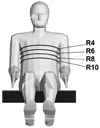
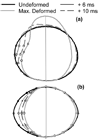
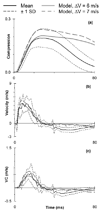

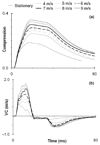
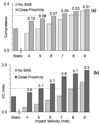

Similar articles
-
Biomechanical and injury response to posterolateral loading from torso side airbags.Stapp Car Crash J. 2010 Nov;54:227-57. doi: 10.4271/2010-22-0012. Stapp Car Crash J. 2010. PMID: 21512911 Free PMC article.
-
Injuries in Full-Scale Vehicle Side Impact Moving Deformable Barrier and Pole Tests Using Postmortem Human Subjects.Traffic Inj Prev. 2015;16 Suppl 2:S224-30. doi: 10.1080/15389588.2015.1062887. Traffic Inj Prev. 2015. PMID: 26436236
-
Chest injuries of elderly postmortem human surrogates (PMHSs) under seat belt and airbag loading in frontal sled impacts: Comparison to matching THOR tests.Traffic Inj Prev. 2018;19(sup2):S55-S63. doi: 10.1080/15389588.2018.1542139. Epub 2018 Dec 13. Traffic Inj Prev. 2018. PMID: 30543304
-
Eye injury and the air bag.Curr Opin Ophthalmol. 1995 Jun;6(3):38-44. doi: 10.1097/00055735-199506000-00007. Curr Opin Ophthalmol. 1995. PMID: 10150868 Review.
-
An overview of frontal air bag performance with changes in frontal crash-test requirements: findings of the Blue Ribbon Panel for the evaluation of advanced technology air bags.Traffic Inj Prev. 2008 Oct;9(5):421-31. doi: 10.1080/15389580802046250. Traffic Inj Prev. 2008. PMID: 18836952 Review.
Cited by
-
Biomechanical and injury response to posterolateral loading from torso side airbags.Stapp Car Crash J. 2010 Nov;54:227-57. doi: 10.4271/2010-22-0012. Stapp Car Crash J. 2010. PMID: 21512911 Free PMC article.
-
Door velocity and occupant distance affect lateral thoracic injury mitigation with side airbag.Accid Anal Prev. 2011 May;43(3):829-39. doi: 10.1016/j.aap.2010.11.002. Epub 2010 Dec 4. Accid Anal Prev. 2011. PMID: 21376873 Free PMC article.
References
-
- Braver ER, Kyrychenko SY. Efficacy of side air bags in reducing driver deaths in driver-side collisions. Am.J.Epidemiol. 2004;Vol. 159:556–564. - PubMed
-
- Cavanaugh JM, Walilko TJ, Malhotra A, Zhu Y, King AI. Biomechanical response and injury tolerance of the thorax in twelve sled side impacts. Proc. 34th Stapp Car Crash Conference; 1990. pp. 23–38.
-
- Copes WS, Champion HR, Sacco WJ, Lawnick MM, Gann DS, Gennarelli TA, MacKenzie E, Schwaitzberg S. Progress in characterizing anatomic injury. J.Trauma. 1990;Vol. 30:1200–1207. - PubMed
-
- Dalmotas D, German A, Tylko S. The crash and field performance of side-mounted airbag systems. Proc. 17th International Technical Conference on the Enhanced Safety of Vehicles, Paper 442.2001.
Publication types
MeSH terms
Grants and funding
LinkOut - more resources
Full Text Sources
Medical
